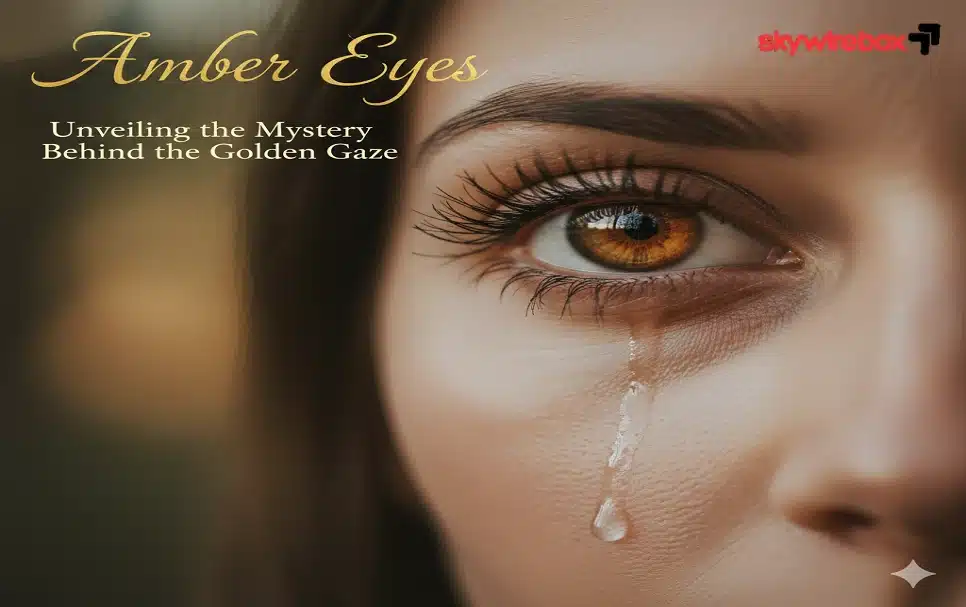Have you ever caught yourself staring into a pair of eyes that seem to glow with a warm, golden fire? Those captivating amber eyes hold a unique charm that’s hard to ignore.
If you’ve wondered whether your eyes might be amber or simply a shade of brown or hazel, you’re not alone. Amber eyes are one of the rarest eye colors in the world, and their striking, honey-gold glow sets them apart from the rest.
You’ll discover what makes amber eyes so special, why they’re so rare, and how to tell if you truly have this mesmerizing eye color. Ready to unlock the secrets behind those golden orbs? Keep reading—you might just see your own eyes in a whole new light.
Rarity Of Amber Eyes
Amber eyes are quite rare and unique. This eye color comes from a mix of lipochrome and melanin. Lipochrome gives the eyes a golden or yellowish tint. Melanin adds darker shades, balancing the color.
People with amber eyes have more lipochrome and less melanin than those with brown eyes. This makes their eyes shine like honey or gold. The mix of these pigments creates the warm, glowing look.
| Ethnic Group | Frequency of Amber Eyes |
|---|---|
| Asian | Moderate |
| South American | Higher |
| European | Rare |
| African | Very Rare |
Amber eyes appear more in some regions. They are less common in Europe and Africa. Genetics and geography both shape this rare eye color.
Genetic Factors Behind Amber Eyes
Amber eyes result from unique genetic variations affecting eye color. These variations change the amount and type of pigment called melaninin the iris. Higher levels of a yellow pigment, pheomelanin, give eyes their golden or coppery look.
Genes like OCA2and HERC2play important roles in eye color. They control melanin production and distribution. Small changes in these genes can create rare shades like amber.
| Inheritance Pattern | Explanation |
|---|---|
| Polygenic | Multiple genes affect amber eye color, not just one. |
| Dominant and Recessive | Amber can appear if certain dominant or recessive genes combine. |
| Complex | Eye color inheritance involves many gene interactions. |
The amber eye color is rare because it needs a specific mix of genes. Family members may share this trait, but it can skip generations.
Color Characteristics
Amber eyes show a mix of golden and copper tones. These colors give the eyes a warm, glowing look. The golden shades look like soft sunlight, while the copper tones add a rich, fiery depth.
Light amber eyes often appear bright and clear. They can look like honey or soft gold. Deep amber shades are darker, with strong reddish or brown hints. These deeper tones make the eyes look intense and mysterious.
| Shade | Color Features | Effect on Appearance |
|---|---|---|
| Light Amber | Bright gold, honey | Soft, warm, glowing |
| Deep Amber | Rich copper, dark gold | Intense, mysterious, warm |
Amber Vs Similar Eye Colors
Amber eyes shine with a warm, golden hue. They differ from hazel eyes which often mix green, brown, and gold tones. Hazel eyes change color based on light and surroundings. Amber eyes stay a consistent rich yellow or copper shade.
Brown eyes are usually darker and lack the golden glow of amber eyes. Brown eyes can range from light to dark but do not have the translucent, almost glowing quality amber eyes have. Amber eyes look like a mix of brown and gold.
Global Distribution
Amber eyes are more common in Asia, especially in Southeast regions. They appear as a mix of golden and brown shades. This unique color results from a special pigment called lipochrome. Many people in these areas have this eye color naturally.
In South America, amber eyes are present but less frequent. They mostly show up in people with mixed heritage, including Native American and European roots. The color often looks like a warm, glowing gold.
Southern Europe also has some cases of amber eyes. Countries like Spain and Italy have small numbers of people with this rare eye color. It adds to the diverse range of eye colors found in this region.
Cultural Significance

Amber eyes have fascinated people for centuries. Many myths and legends tell stories about their magical power. Some believe these eyes bring wisdom and strength. Others think they can see the future or protect from harm.
In different cultures, amber eyes hold special meanings. For example, in some Asian cultures, they symbolize good luck and prosperity. In Europe, they often represent mystery and courage. Native American tribes sometimes see them as a sign of a spiritual connection.
The golden color of amber eyes is linked to the sun and fire. Many cultures use this color to show energy, passion, and life force. This symbolism makes amber eyes unique and deeply respected.
Enhancing Amber Eyes
Makeup tips for amber eyes focus on warm colors. Shades like copper, gold, bronze, and peach make the eyes pop. Use a soft brown or deep plum eyeliner to add depth. Avoid cool tones like blue or silver as they can dull the warmth.
For lashes, a volumizing black or brown mascara works best. Adding a touch of highlighter at the inner corners brightens the eyes.
| Contact Lens Color | Effect on Amber Eyes |
|---|---|
| Honey | Enhances natural warmth |
| Green | Creates a striking contrast |
| Brown | Deepens eye color softly |
| Gray | Gives a subtle, cool tone |
Frequently Asked Questions
Is It Rare To Have Amber Eyes?
Amber eyes are rare due to high lipochrome and low melanin levels. This unique genetic trait appears mostly in Asian, South American, and Southern European populations.
What Ethnicities Have Amber Eyes?
Amber eyes appear in various ethnicities, including Asian, South American, and Southern European groups. This rare color results from high lipochrome and low melanin levels.
What Are The Top 3 Rarest Eye Colors?
The top 3 rarest eye colors are green, amber, and gray. Green eyes occur in only 2% of the population. Amber eyes have a unique golden hue caused by lipochrome pigments. Gray eyes are extremely rare, featuring low melanin and a distinct light appearance.
What Causes Dark Amber Eyes?
Dark amber eyes result from high lipochrome (yellow pigment) and low melanin levels in the iris. Genetics cause this rare eye color.
Conclusion
Amber eyes captivate with their warm, golden glow. They stand out as one of the rarest natural eye colors worldwide. This unique shade results from specific pigments and light reflection. Many find amber eyes mysterious and beautiful. Understanding their rarity adds to their charm.
People with amber eyes often receive compliments on their striking look. Embracing this eye color means celebrating a special genetic gift. Whether in sunlight or shade, amber eyes always draw attention. Their blend of gold, copper, and honey hues creates endless fascination. Our all update get to visit our website: skywirebox
Amber eyes truly offer a rare and natural beauty.









